Подсвечники и принадлежности для свечей
Подсвечники и принадлежности для свечей.
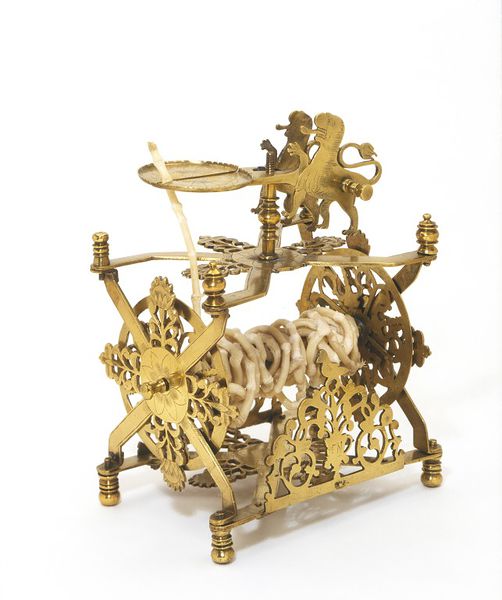
"Долгоиграющая" свеча

Candlestick with a Figure of a Monkey-Conductor , Circa 1753

Из коллекции zuzlishka .Колпачок для тушения свечи
=============================================

A Candle maker
Object:Painting
Place of origin:Guangzhou (made)
Date:ca. 1790 (made)
Древние свечи значительно отличались от современных и содержанием и внешним видом. Используя доступные природные ресурсы, человек придавал свечам довольно причудливые формы. Некоторые свечи представляли собой длинные трубки из волокнистого материала, такого как камыш, наполненные смолой. В Китае и Японии свечи производили из воска. Его получали из насекомых и семян растений, а затем эту массу формовали в бумажные трубочки.
В получившуюся восковую форму помещали фитиль, который изготавливали из волокон растений. Много столетий спустя, в 18 веке, фитиль стал хлопковым, и его заливали жиром или воском, а не вставляли в готовую свечу.
Технология получения воска у каждого народа своя. Коренные американцы жгли масляную рыбу (candlefish), надетую на разветвленную палку. В юго-западных районах Северной Америки использовалась кора специального дерева, которую жгли, таким образом извлекая воск. Поселенцы Новой Англии жгли восковник - дерево, насыщенное смолой. Потом полученной массе придавали форму, вставляли фитиль.
Но подобные технологии были довольно трудоемкими и не оправдывали себя. К примеру, требовалось полтора кубометра восковника, чтобы сделать 8-дюймовую тонкую свечку. А потом, можете ли вы себе представить, как пахли и коптили эти свечи?
Потребность - мать изобретения. И человечество постепенно переходит к использованию животного жира для получения воска. Также начали использовать и пчелиный воск, в основном из-за его аромата. Эти свечи были довольно дорогим удовольствием, но горели намного ярче, чем их собратья из жира.
Несколько позже появился еще один материал, составивший большую конкуренцию воску и жиру - спермацет. Его получали из вещества, содержащегося в головах китов. Спермацетовые свечи горели намного ярче восковых - они были настолько яркими, что свет спермацетовой свечи использовался в качестве стандарта в фотометрии. Но по понятным причинам в 20 веке добыча спермацета была запрещена и прекращена.
В 15 веке сменилась технология формования свечи. Если раньше воск заворачивали, то теперь он заливался в готовую форму, которая после высыхания воска снималась.
-------------------Подсвечники-----------------------------
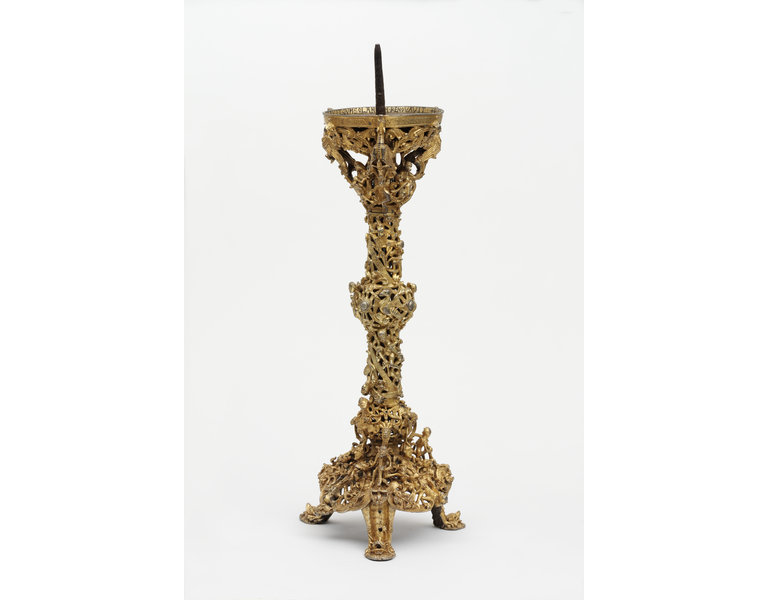
The Gloucester Candlestick
Object:Candlestick
Place of origin:England (made)
Date:1104-1113 (commmissioned)
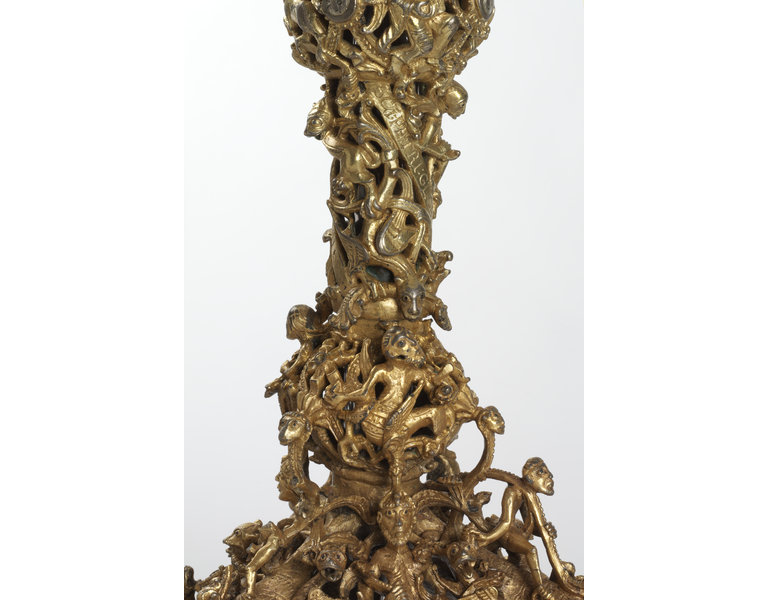

Англия (сделано)
Date: Дата: 1104-1113 (commmissioned) 1104-1113 (commmissioned)
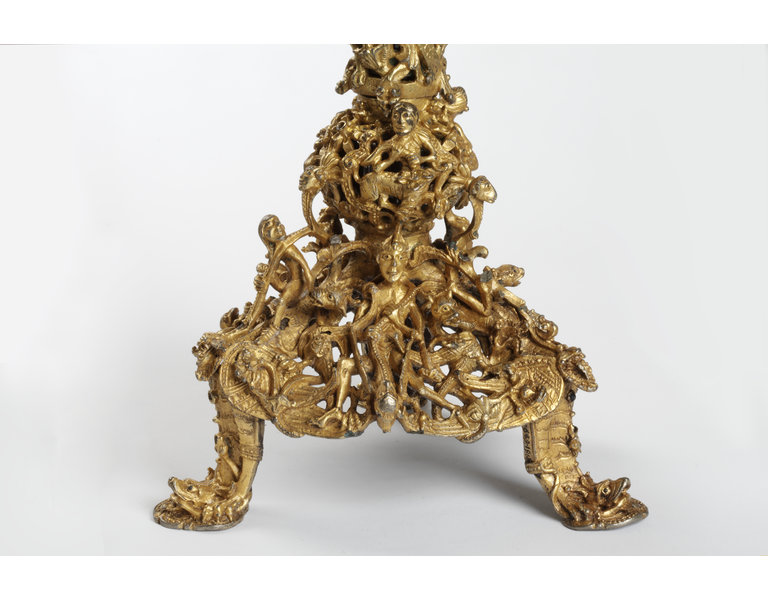
. This unique candlestick is a masterpiece of English metalwork, probably made by a goldsmith. It is made in three sections, each separately cast by a process known as 'lost wax'. The dense decoration is formed of wonderful figures and apes interspersed between thick intertwining shoots of foliage. Three long-eared dragons with outspread wings form the supporting feet. The large knop (or knob) in the centre of the stem shows the symbols of the four Evangelists.
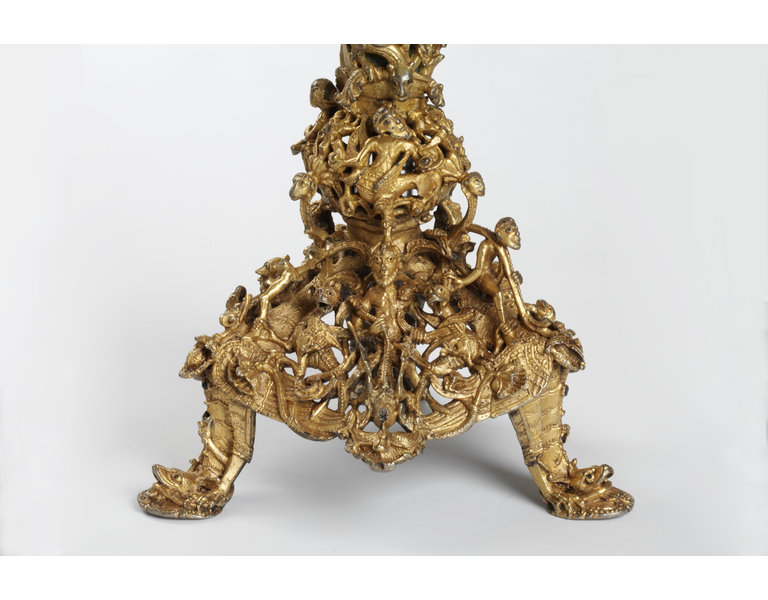
-------------------------------
-----------------------свечное производство в Европе-----------------------
Свечи были очень дорогими, и не каждому хватало средств на их приобретение. Главным местом использования свечей были церкви, и таким образом церковь производила их для своих нужд, продавая часть этой продукции состоятельным семьям.
Такое положение вещей предстояло изменить. Не только лишь богатые жили на этом свете, и требовались заменители дорогих свечей для широкого общественного потребления. В этих целях около 13-го века для обеспечения менее зажиточных семей в Англии и Франции начали создаваться первые надомные фабрики свеч, где производились свечи для нужд жителей домов а также для последующей продажи.
Такие малые свечные производства и людей, которые там трудились, называли (Chandler-ami). Человеческая изобретательность не знает границ и вскоре возникали целые технологические линии, которые впрочем не выглядели как традиционные машины. Кто-то может подумать, что производство это было слишком примитивным, однако же на самом деле оно было весьма продуманным и практичным. Можно было производить все больше и больше не только на собственные нужды. Появлялись и первые машины. В таких надомных фабричках началось производство свечей, которые выделяли иной запах, нежели прежний «аромат» сгорающего жира. Наконец наметился определенный прогресс: начали добавлять ягоды барбариса, и это привело к тому, что во время сгорания выделялся сладкий, хотя и тошноватый запах, а пламя становилось ярче и чище.
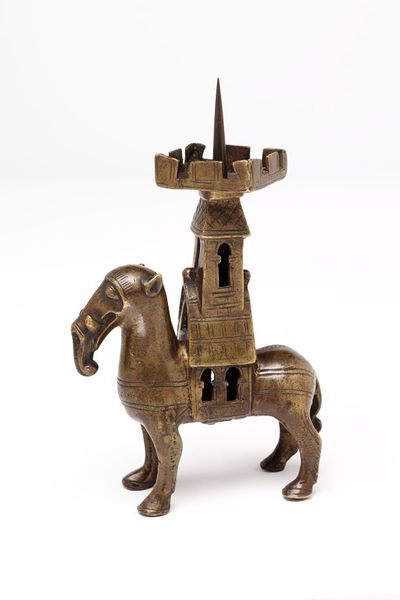
Германия 1200-1400
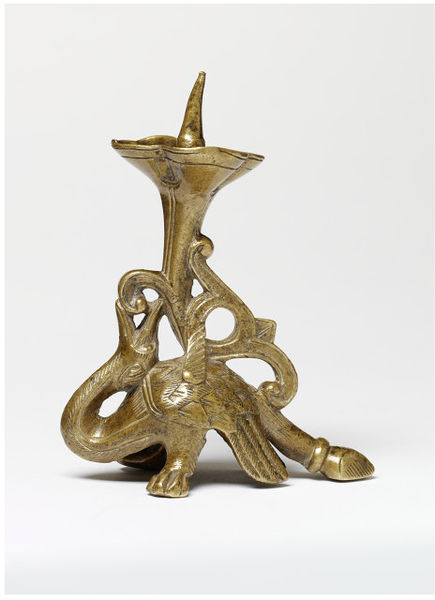
Candlestick
Place of origin:Mosan (made)
Date:ca. 1200 (made)
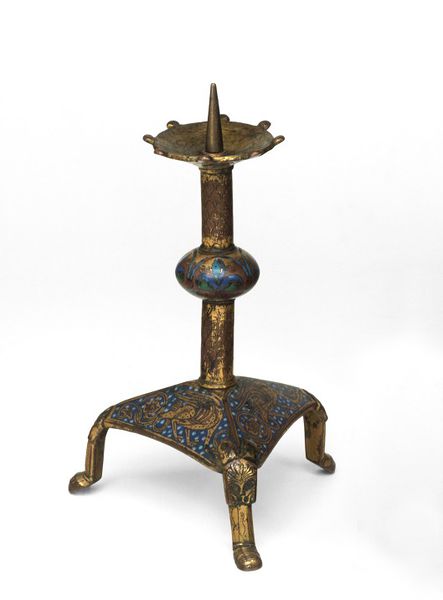
Date:ca. 1300
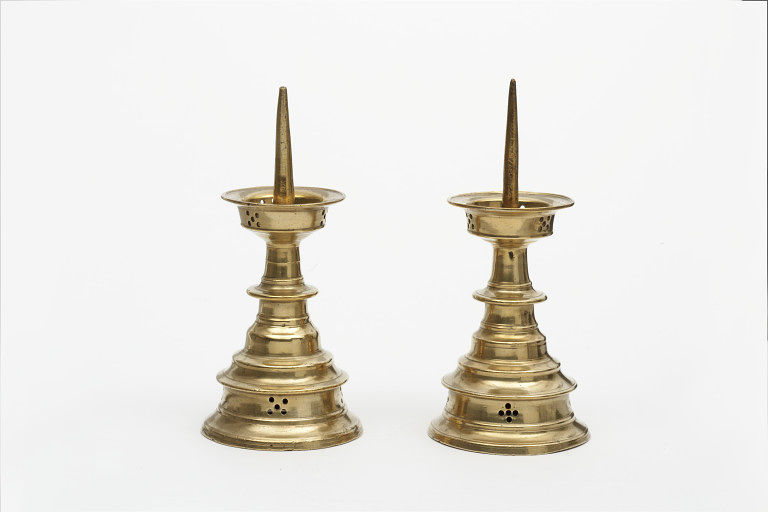
Pair of candlesticks
Place of origin:Belgium (made)
Date:1450-1500 (made)
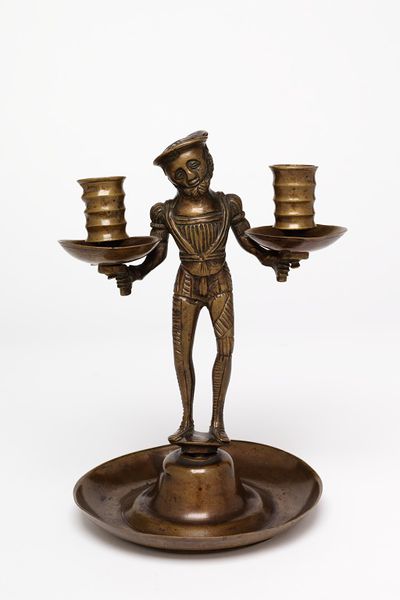
Подсвечники
Place of origin: Место происхождения: Germany (made) Германия (сделано)
Date: Дата: early 16th century (made) начале 16 века
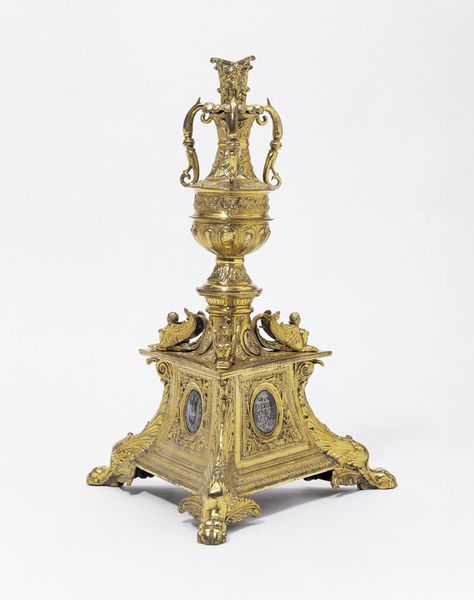
Foot of an altar cross
Place of origin:Italy (made)
Date:1541 (made)
Artist/Maker:Unknown
Materials and Techniques:Gilt bronze, niello
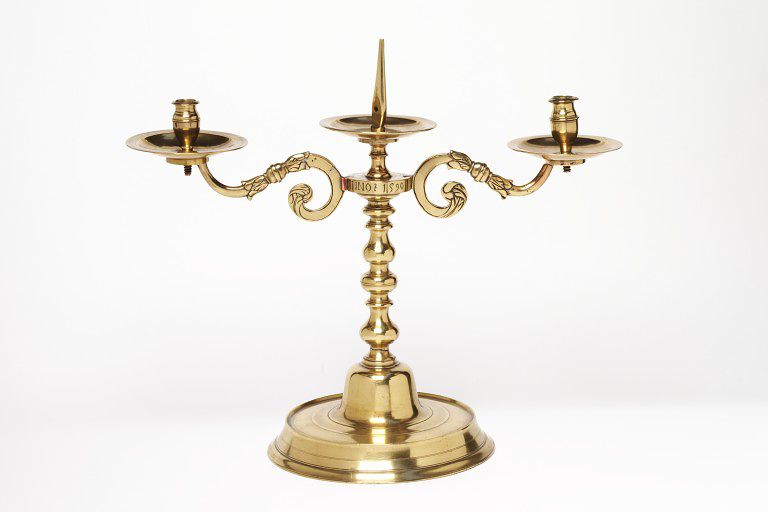
Pair of candelabrum
Place of origin:Iceland (made)
Date:1590 (made)
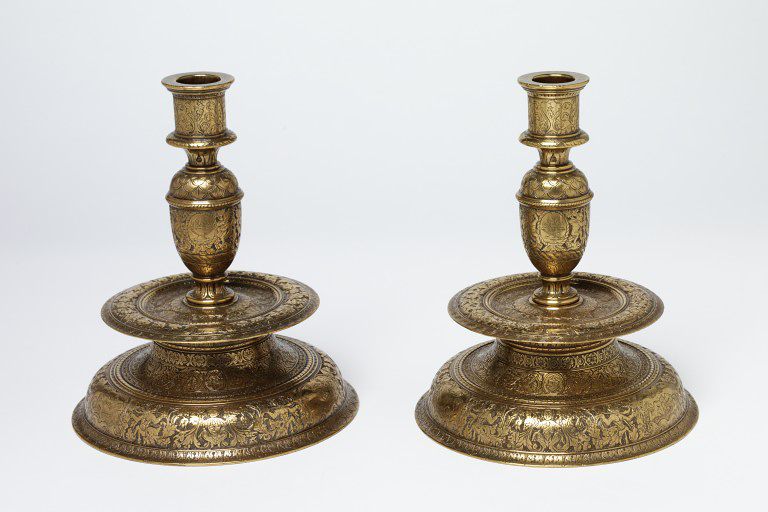
Подсвечники
Place of origin: Место происхождения: Venice (city) (made) Венеция (город) (сделано)
Date: Дата: ca. ок. 1600 (made) 1600 (сделано)
С 14 до 17-го века, медные подсвечники появились во всех богатых домах. Socketed candlesticks made their appearance in the late 13th century and thereafter became relatively common, replacing the earlier pricket form, at least for domestic use. Socketed подсвечники появились в конце 13 века, заменив форму "годовалый олень".
Первый случай изменений с использованием иного рода сырья для производства свечей приходится на 18 век, когда в производстве начато использование спермацета (масло спермацетовое, олброт) - жидкая субстанция, содержащаяся в голове, а точнее - в огромном вместилище над правым носовым проходом кашалота. Спермацет свою текучую консистенцию сохранял только внутри кашалота. Однако и будучи извлеченным оттуда не был так тверд, как того хотелось бы. И хотя его открытие не решило проблему устранения неприятного запаха, однако же позволило придать свече большее пламя.

серебро 1740
Нимфа Дафна бежит от олимпийского бога Аполлона, мужской фигуры. She finally escapes by turning into a laurel tree, symbolising the victory of Chastity over Desire. Наконец, она убегает, превращаясь в лавровое дерево, символизирующее победу над желанием целомудрие. Figural candlesticks had been known in antiquity and were popular in Europe from the 16th century. Фигурная свеча была известна в древности и были популярны в Европе в 16 веке.

Chamber candlestick.
Place of origin:London (made)
Date:1744-1745 (hallmarked)
Artist/Maker:Crespin, Paul (maker)
Materials and Techniques:Silver, embossed, cast, chased and engraved, originally gilt

pair of candlesticks in giltbronze decorated with foliages and resting on a tripod base representing three winged lions.

19 век

pair of antique figural candlesticks modelled as emus standing on rocky bases. The candle tops having grape decoration. Height 25 cms. Circa 1890.
---------------------------------Переносные подсвечники-------------------------------
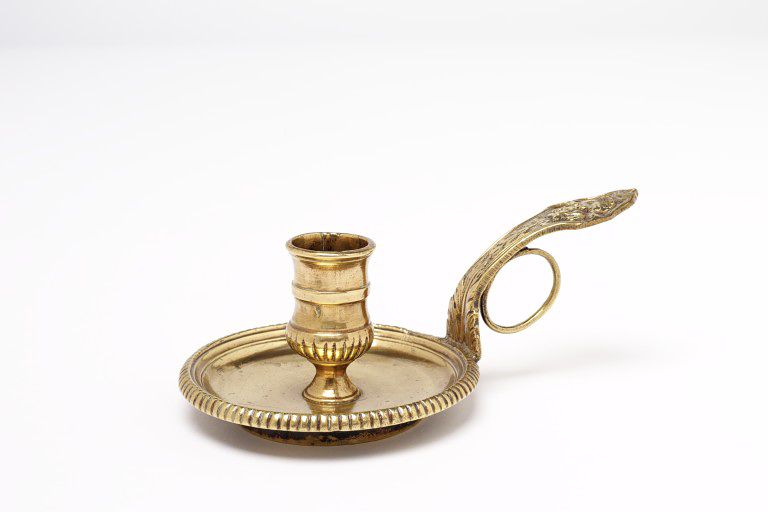
Candlestick
Place of origin:France (made)
Date:ca. 1700 (made)
chamberstick,подсвечник для спальни стороны- подсвечник предназначен для переноски, чтобы осветить путь в помещении. It consists of a small flat tray or shallow, saucer like dish with a low central support for the candle.

Figurine
Date:19th century (made)
Artist/Maker:Unknown
Materials and Techniques:Moulded bronze
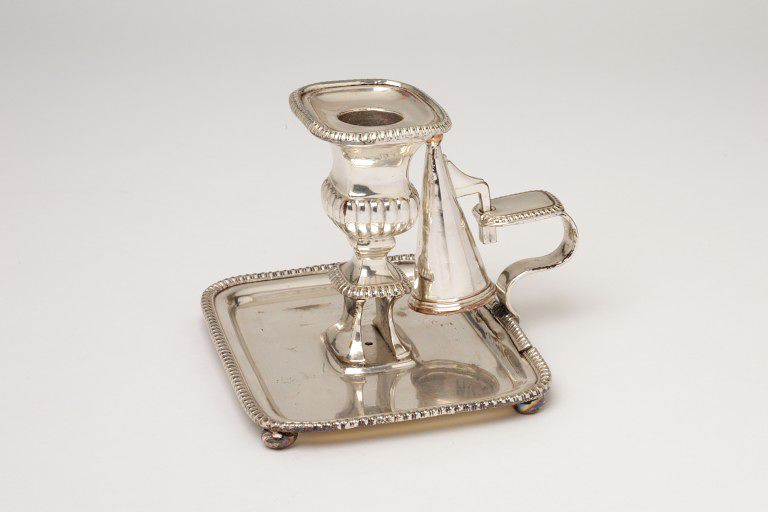
Candlestick
Place of origin:Sheffield (made)
Date:early 19th century (made)
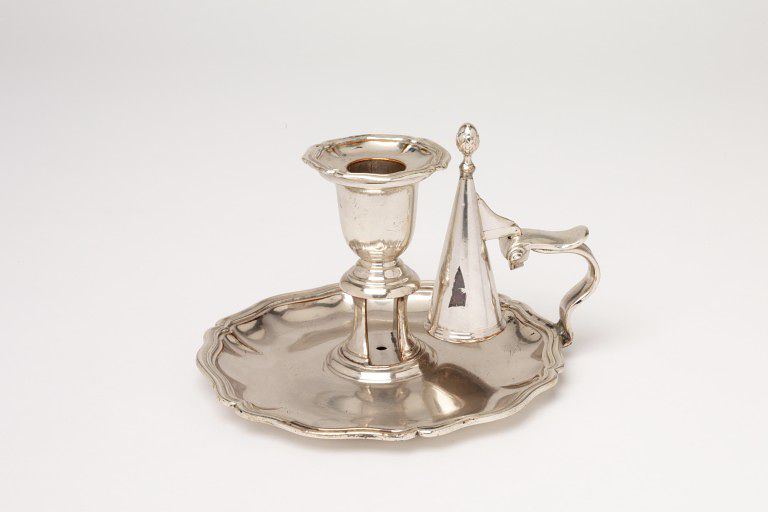

William IV Silver Chamber Stick
A small and extremely pretty antique sterling silver chamber stick with a naturalistic leaf base. Matching snuffer (unmarked). Base 7.5 cms x 7 cms. London 1833. By Taylor and Perry.

-----------------------------Коробочки-------------
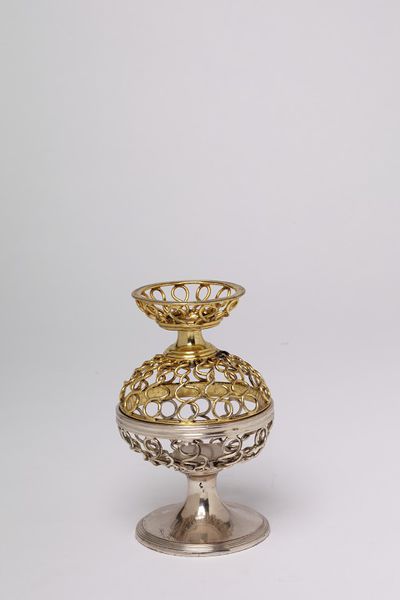
Taper box
Place of origin:Sheffield (made)
Date:late 18th century (made)
в основном использовался для плавления сургуча и зажигать свечи, курительные трубки и т.д., а не как источник освещения.
A taper box or ‘bougie box’ was a cylindrical type of box to hold a wax taper coil. The name is derived from the French word for candle, bougie, which is derived in turn from Bougia, an Algerian town which exported wax. This box is an unusual variant in that the coiled wax was enclosed in an openwork, wire mesh cage. The taper was used mainly for melting sealing wax and for lighting candles, tobacco pipes etc., and not as a source of illumination.
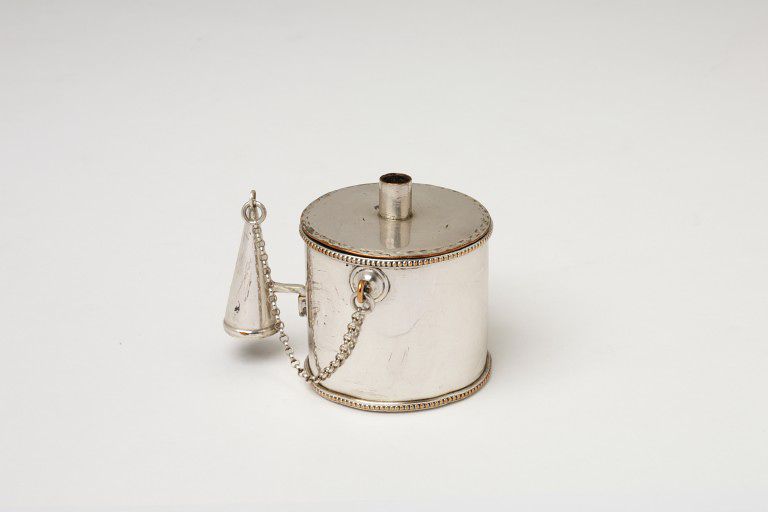
Taper box
Place of origin:Sheffield (made)
Date:ca. 1790 (made)
A taper box or ‘bougie box’ was a cylindrical box to hold a wax taper coil. The name is derived from the French word for candle, bougie, which is derived in turn from Bougia, an Algerian town which exported wax.
The box, made of Sheffield plate, has a slip on cover with a tube or socket at the top from which the coiled taper can emerge and be held upright. Some taper boxes, like this example, had a candle extinguisher, a small hollow cone which was placed over the lighted taper to extinguish the flame without causing the snuff to smoke. The extinguisher is attached to the side by a short chain and a hook which slides into a sleeve. The taper was used mainly for melting sealing wax and for lighting candles, tobacco pipes etc., and not as a source of illumination
------------------------канделябры---------------
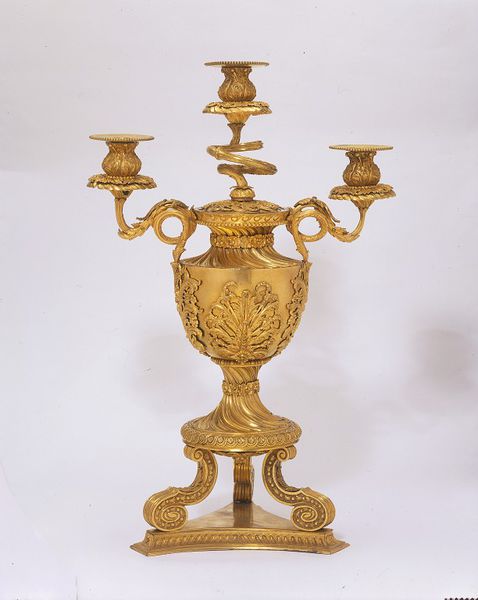
Candelabrum
Place of origin:London (made)
Date:ca. 1760 (made)
Artist/Maker:Stuart, James 'Athenian' (after, designer)
Anderson, Diederich Nicolaus (probably, maker)
Materials and Techniques:Ormolu (gilt bronze), with cast and applied decoration
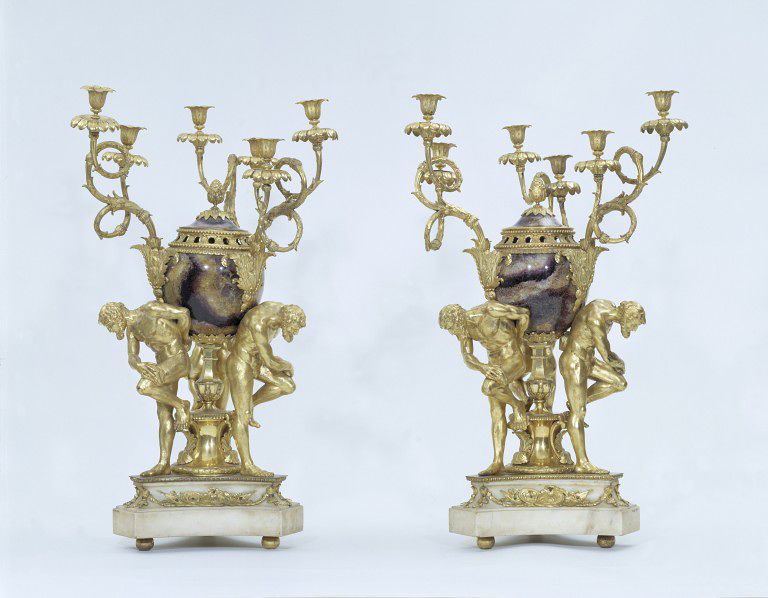
Candelabrum
Place of origin:Birmingham (made)
Date:ca. 1771 (made)
Artist/Maker:Adam, Robert (probably, designer)
Boulton, Matthew (maker)
Materials and Techniques:Blue-john (fluorspar) with gilt bronze and silvered copper mounts

Candelabrum, Centrepiece
Place of origin:London (assayed)
Date:1813-1814 (hallmarked)
Artist/Maker:Storr, Paul (maker)
Materials and Techniques:Silver-gilt, raised, cast, chased, engrav

Pair of Louis XVI Style Gilt Bronze Seven Light Candelabra after the model by François Rémond for Le comte de Artois' Turkish boudoir at Versailles.
François Rémond (1747 -1812), was a leading Parisian gilder and bronze caster during the second half of the 1700s.

Pair of large candelabra with five branches, in gilded and patinated bronze. It is in the shape of a woman dressed in the Greek fashion, standing on a square pedestal and bearing the lights on her head and in her hands.
18th century

A Large and Very Finely Cast Pair of Ormlu, Bronze and Marble Figural Candelabra, After A Model by Clodion. Claude Michael Clodion, (1738-1814),

An Impressive Pair Of Palatial Louis XV Style Figural Ormolu Mounted Imari Porcelain Candelabra On Ebonised Stands.
В 19 веке происходит расцвет свечного дела. Появляются первые сообщения о свечах стандартных из спермацета, рецептурах и способах их изготовления. Очевидно, что каждая мануфактура имела свои технологические секреты, однако вскоре употребляется слово стандарт, что указывает на то, что свечи начали производиться массово с применением указанного сырья и по определенной технологии. Наконец решена проблема коптящих фитилей. Внедряются фитили прессованные и плетеные, что позволило улучшить качество горения и стабильность пламени свечи.
Французский химик Мишели Эжен Шеврел в 1820 году изобрел фантастическое сырье, которое по сей день применяется в качестве улучшителя парафина. Речь идет о стеариновой кислоте, получаемой из кислоты жирных животных путем гидролиза в условиях высокой температуры под большим давлением. Слишком сложно и невозможно было получение такого сырья в домашних условиях тех времен, однако было положено начало исследованиям в области новой технологии. Стеариновый воск был крепким, твердым и горел чисто. Так одним махом были решены проблемы прочности материала, качества и чистоты горения, а в сочетании с изобретением плетеных фитилей свечи приблизились к идеалу. Правда, дальнейшее использование натурального сырья, получаемого из животных, их количество (имеются в виду кашалоты) стремительно уменьшалось.
-----------------ампир------------------------

Very rare and important pair of torches bronze eight arms of light, then Prime Empire
----------------------------

Empire Bronze Doré Candelabra

Chiselled
Main material : Gilded bronze
Period of creation : 1810
Country of creation : France

Empire Bronze Doré Candelabra
----

Gilded bronze
Period of creation : 1810
Country of creation : France

1830
В 1834 году Йозеф Морган сделал прорыв в будущее, сконструировав машину для производства свеч. Это было механическое устройство, в котором впервые применялась форма. Она имела вид цилиндра, снабженного двигающимися поршнями, которые выталкивали готовую, уже остывшую свечу. Изобретение такого оборудования существенно увеличило массовое производство свеч.
Последнее упоминание о важнейшем изобретении в свечном деле относится к 1850 году, когда на рынке впервые появилось сырье, получаемое не из животных. Это был парафиновый воск, в дальнейшем названный парафином, производимый путем отделения натуральных восковых субстанций из нефти. Это был продукт в наибольшей мере соответствующий требованиям, предъявляемым потребителями свечей. Он имел кристаллически белую окраску, был прочным, горел небесно-белым пламенем и не выделял неприятного запаха.
======================Канделябры-цветы=======

Pair of crystal chandeliers and gilded bronze, creating signed "E. enote, PARIS. 19th century

Pair of crystal chandeliers and gilded bronze, creating signed "E. enote, PARIS.
-------------------------
---------------

One of a Pair of Candelabra, c.1855
Collection: Ceramics
One of a pair of candelabra, c.1855 Hard-paste porcelain, coloured enamels and gilt-bronze Painted with a portrait of Marie-Antoinette French, Monbro Height:

candelabrum
One of a Pair of Candelabra, c.1855
One of a Pair of Cabndelabra, c.1855
Portrait of King Louis XVI
Hard-paste porcelain, coloured enamels and gilt-bronze
French, Monbro
Period: Napoleon III

Large 19th Century Pr. French Brass Floral Candelabra

A unique pair of French brass floral candelabra from the 19th Century, having 9 lights and intricately embellished with brass leaves and grapes. Please view all pictures to appreciate the great detail and quality.

pair of French brass floral candelabra from the 19th Century

Impressive 19th Century French Bronze Candelabra
-----------------------------Настенные подсвечники----------------------------------------

Italian Renaissance style (19th Cent) metal wall sconce bracket of arm in armour holding torch

Italian Renaissnce style (19th Cent) carved and painted wall sconce of arm holding torch with kneeling figure

LION MASK SCONCES-КАНДЕЛЯБРЫ
Pair Carved Wood Gilt Lions Mask with Arms Venetian 18th C.

Pair of Italian Renaissance style (19/20th Cent) gilt metal wall sconces with winged griffin form with new 8 sided shade

Exceptional pair of carved wood sconces, gilding and silvering of origin. Rome, XVIII.
45,000 €

Girandole
Place of origin:London (probably, carved)
Date:1760-1765 (made)
Artist/Maker:Johnson, Thomas (after, designer)
'Girandole' is an Italian name for a wall light. Wooden wall lights were introduced in the late 17th century and were common by the mid-18th century. The Rococo style gave free reign to the carver's invention.

A pair of French Louis XV style gilt bronze sconces with three light branches shaped as foliage and a rocaille stem ornamented with flowers.

Each sconce is made in the form of lyre, culminating in the top two heads Zefirov and adorned with laurel branches, with a mask of Apollo in the center 19 век

Pair of French Neoclassical Mid-19th Century Gilt and Patinated Bronze Five Light Wall Lights. Circa: 1850.

A Large and Important Pair of French 19th Century Louis XV Style Gildwood Carved Six Light Wall Appliques, Circa: Paris, 1870
40,000 €

Pair of gilt bronze appliques on fire two lights, with cherub's face, Louis XV, 1745 circa.

Pair of large three-light sconces. By Jean-Joseph de Saint-Germain. Probably executed after a drawing by Jean-Louis Prieur. Paris around 1765 - the end of Louis XV period. Ormolu.
----------------------Напольные большие канделябры---------

19th century

A pair of gilt wrought iron torch holders

Pair of Italian Baroque style stripped pine, beech & poplar 24 arm floor torcheres with 3 scrolling legs on horses (in the manner of Piranesi, 19th Century & with replacements)

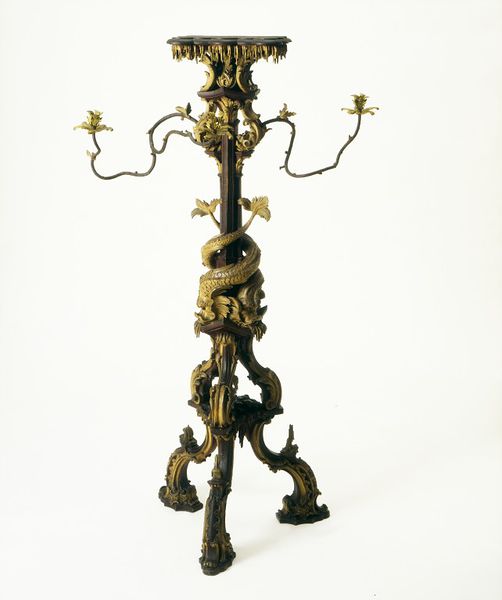
Candlestand
Place of origin:London (probably, made)
Date:1756-1760 (made)
Artist/Maker:Johnson, Thomas (probably, designer and maker)
Materials and Techniques:Carved and painted pine, with iron branches and gilt-brass nozzles
This is one of a set of four stands made to hold candelabra to light a room. The lively design with imagery from nature is typical of the Rococo style in Britain in the 1760s.
============================Фарфоровые канделябры==

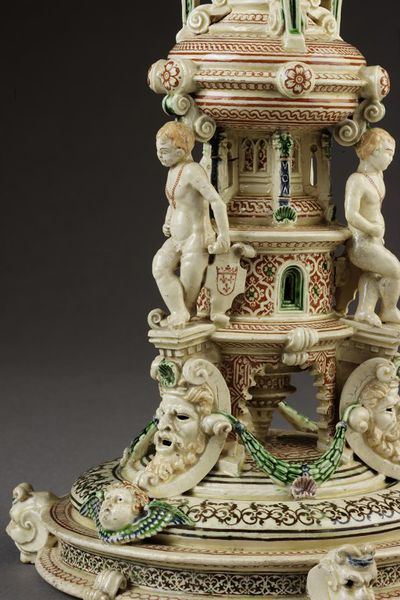
Париж (возможно, и сделал)
Fontainebleau (possibly, made) Фонтенбло (возможно, и сделал)
Date: Дата: ca. ок. 1547-1559 (made) 1547-1559 (сделано)
Artist/Maker: Исполнитель / Производитель: Palissy, Bernard (possibly, maker) Палисси, Бернард
"faïence Анри де-II", поскольку эмблема французского короля и его жены Екатерины Медичи, вместе с тем, как тогда думали, его любовницы Дианы де Пуатье
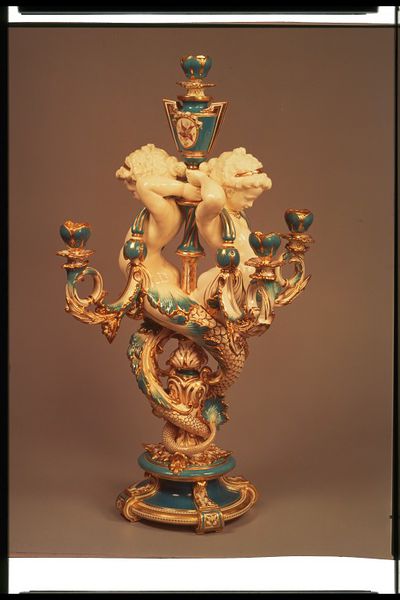
Неизвестный мастер

Candlestick with a Figure of a Monkey-Conductor , Circa 1753

Pair of Bronze Candelabras with Porcelain Flowers & Birds
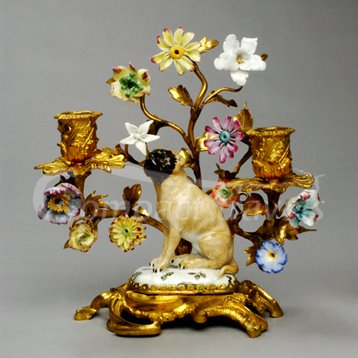
Meissen porcelain manufactory.

Four Seasons Porcelain Candelabra by Samson & Sons-

FRENCH BRONZE & PORCELAIN BIRD BRANCH ORNAMENTAL DISPLAYS

PAIR FRENCH ORMOLU BIRD BRANCH DISPLAYS PORCELAIN FLOWERS
pair of highly decorative bronze branches with porcelain birds and flowers.

PAIR GERMAN PORCELAIN PARROT CANDELABRAS CANDLE HOLDER

Porcelain at Baltimore Museum of Art
-----------------------По мотивам басней Эзопа-----------------------

Candlestick
Part of a pair of Fable candlesticks. This candlestick illustrates Aesop's fable of the Fox and the Tiger.
c. 1765

Candlestick
Part of a pair of Fable candlesticks. This candlestick illustrates Aesop's fable of the Leopard and the Fox.

С хрустальными подвесками
Фарфоровых и хрустальных подсвечников много очень интересных, их покажу в отдельном посте.
==========================Долгоиграющие свечи=================
Спасибо всем, кто написал комментарии к картинке-загадке, а особенно тем, кто прислал фото сербских свечей, я и многие френды не знали, что такие до сих пор есть. Вот еще старинные:
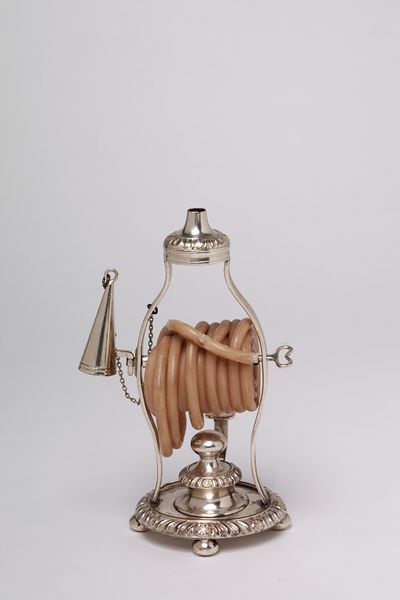
Taper stand
Place of origin:Sheffield (made)
Date:ca. 1820 (made)
Artist/Maker:Unknown
A taper stand, or wax jack, is a device to hold a turpentined wax taper upright while burning. With this example, the coiled taper is wrapped around the vertical post with one end held in the horizontal snuffers, which are two semi-circular blades. The wax taper was used mainly for melting sealing wax and for lighting candles, tobacco pipes etc., and not as a source of illumination.
Sheffield plate originated, with the discovery in 1742, that bars of silver and copper, in unequal proportions, fused by heating under pressure, could be rolled into sheets of laminated metal and worked like silver. The industry this material created flourished for about 100 years until superseded by electroplating in the 1840s.

Taper stand
Place of origin:England (made)
Date:1650-1700 (made)
Artist/Maker:Unknown
Materials and Techniques:Pierced and engraved brass
Его размер и сложные украшения свидетельствуют, что он занимал центральное место в домашнем хозяйстве, наверное, в одном из основных общественных помещений, чтобы зажечь свечи на весь дом. Silver versions of the design of this taper stand are also known.Ownership & Use Собственность & использованию
The coil of taper is held in a split plate tensioned by a spring. Катушка конуса проходит в расколе пластина натянут пружиной. This serves to keep the end of the taper vertical and allows it to burn down only as far as the plate should the flame be left burning. The wax-covered taper would be softened by the heat of the flame and the split plate would then close extinguishing the flame. This was an important feature at a period when accidental fires were very frequent because of the use of lamps and candles for light. Это было важным элементом в период, когда очень часто случались пожары из-за использования ламп и свечей для света.
Materials & Making Материалы & внесении
The pierced designs and engraved dials indicate that this taper stand was either made by a craftsman who was a specialist maker of cases for lantern clocks or was made for a clockmaker, of familiar elements to complement his trade. были либо сделаны мастером, который был специалистом чайник случаев для фонаря часов или было сделано для часовщика, знакомые элементы, которые дополняют его торговли.

An antique sterling silver wax jack with circular base and carrying handle, wax winder and a candle snuffer with chain attached. Height 14 cms. Sheffield 1807. Silver candle snuffer matched.
http://www.waxantiques.com/candlesticks.htm
-------------Ножницы для срезания нагара-----------------------
Тушители Snuffers были впервые изобретены для того, чтобы отрезать фитили свечей, когда вокруг них воск растаял, они не обязательно использовались для тушения пламени свечи. Они впервые появились в 15 веке и многочисленные патенты на такие ножи известны с середины 18 века, регулярно появлялись до 1840 года, когда были разработаны свечи, в которых полностью сгорают фитили, поэтому ножи стали ножи излишними.
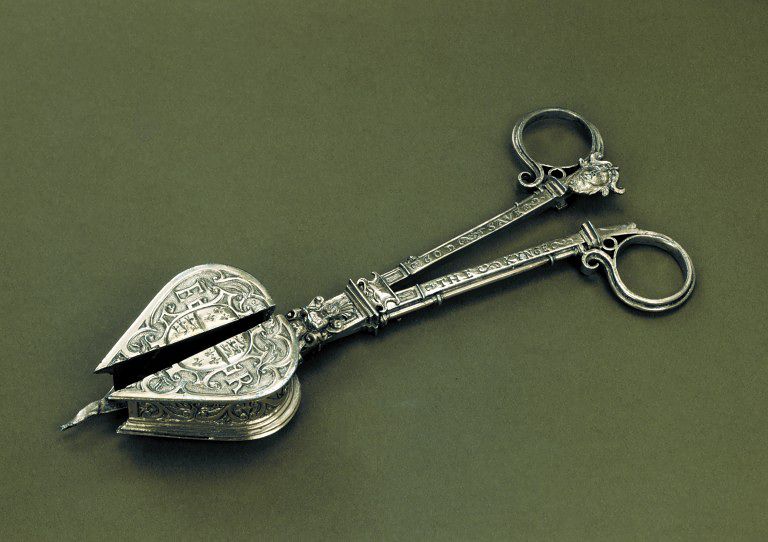
Snuffers
Place of origin:England (made)
Date:1547-1553 (made)
Ножницы Эдуарда VI вместе с Богом надписи 'Сохранить KYNGE' и 'EDWARDE Wythe все его благородные COUNCEL. Edward, the only surviving son of Henry VIII was king from 1547 to 1553 and was succeeded by his half-sisters Mary and Elizabeth. Эдвард, единственный сын Генриха VIII был королем с 1547 по 1553 и ему наследовал его сестры Марии и Елизаветы. The snuffers were passed down through the family of his uncle, Edward Seymour, Duke of Somerset and Lord Protector, who was the brother of Jane Seymour, the King's mother. Ножи были передаются из поколения в семье своего дяди, Эдвард Сеймур, герцог Сомерсет, и лордом-протектором, который был брат Джейн Сеймур, мать царя.
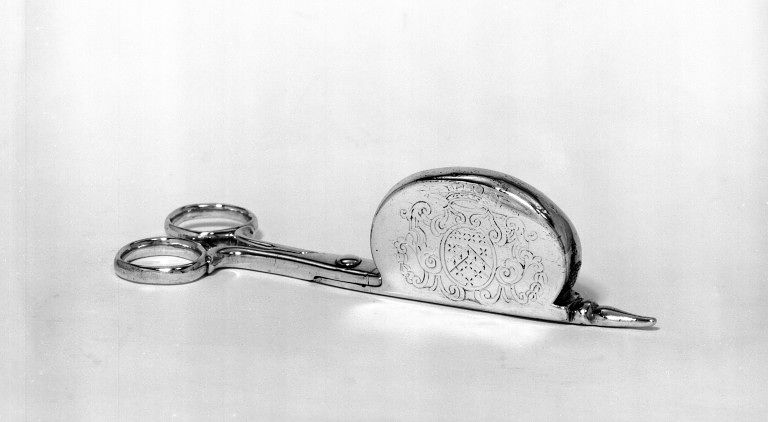
Snuffers
Place of origin:London (made)
Date:ca. 1700 (made)
Artist/Maker:John Chartier (maker)
Materials and Techniques:Silver
----------------------------------
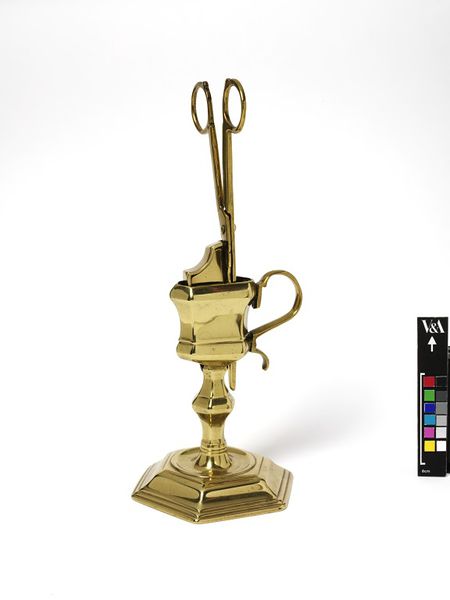
Snuffers with stand
Place of origin:England (made)
Date:ca. 1720 (made)
Сальные и восковые свечи горели быстрее, чем фитиль. Lit candles required constant attention. Зажженные свечи требовали постоянного внимания. Snuffers were used to trim the wicks (to prevent them curling over) and the burnt wicks were captured in the box compartment. Тушители были использованы для отрезания фитилей (чтобы предотвратить их скручивание и сожженных фитили были захвачены в поле отсеке. Snuffers supported in an upright holder such as this were fashionable about 1720. Тушитель поддерживается в вертикальном держателе- как это было модно около 1720.
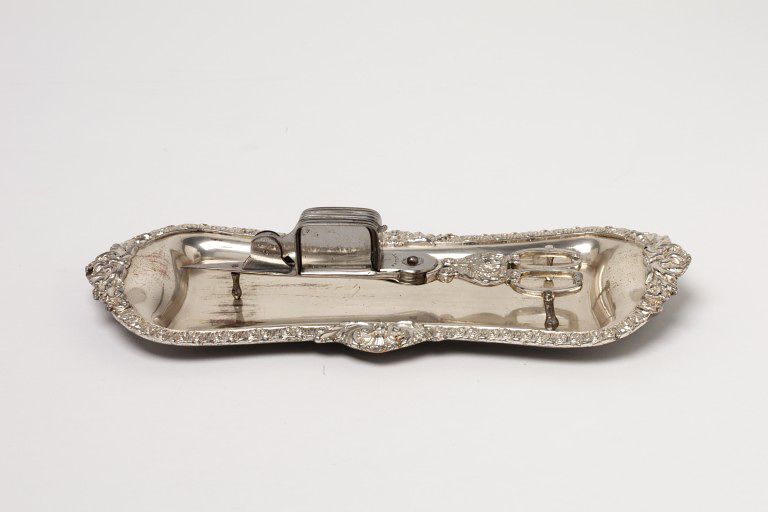
Snuffer tray and snuffers
Place of origin:Sheffield (made)
Date:ca. 1820 (made)
------------------------
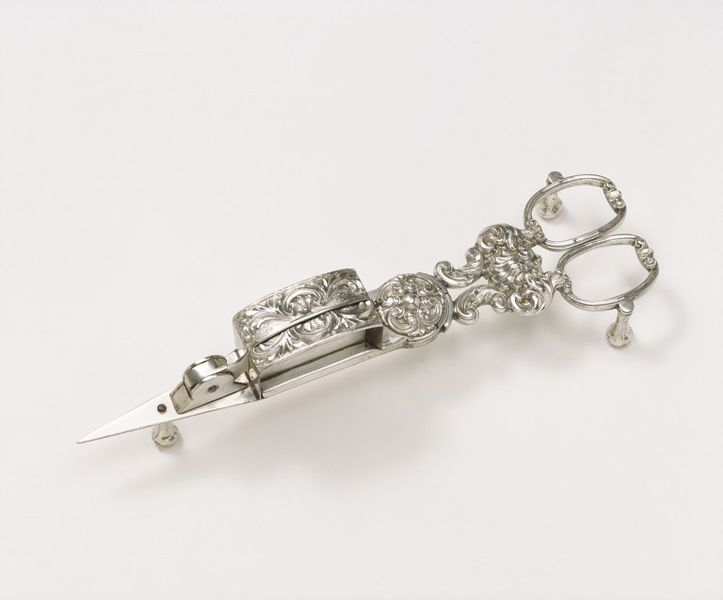
Snuffers
Place of origin:Birmingham (made)
Date:1830-1840 (made)
Artist/Maker:J. Hobday (maker)
Materials and Techniques:Close-plated iron or steel, with lead-filled silver
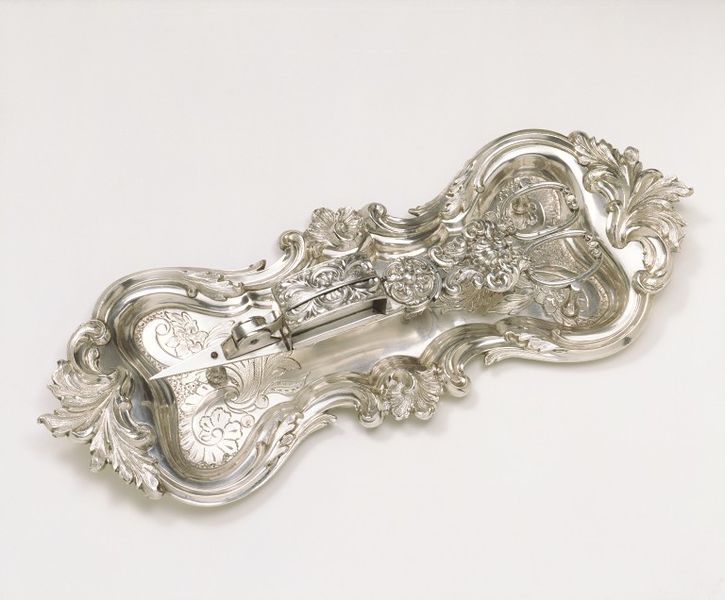
-----------------------
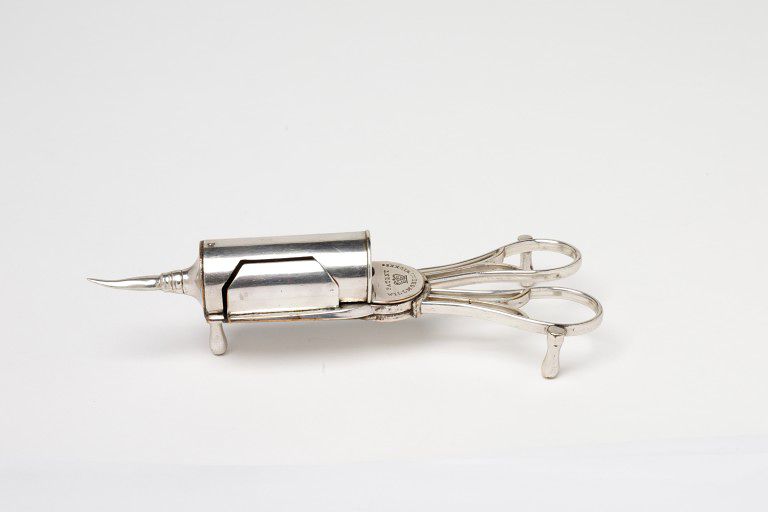
Snuffers
Place of origin:Sheffield (made)
Date:early 19th century (made)
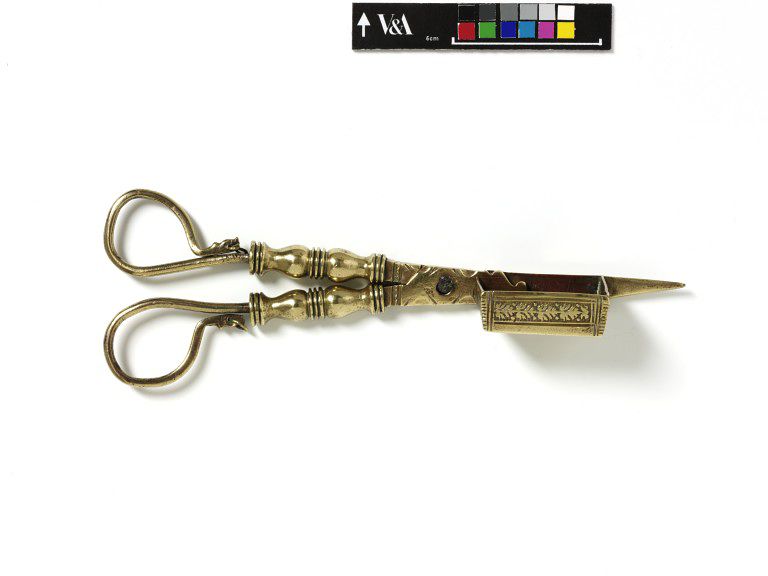
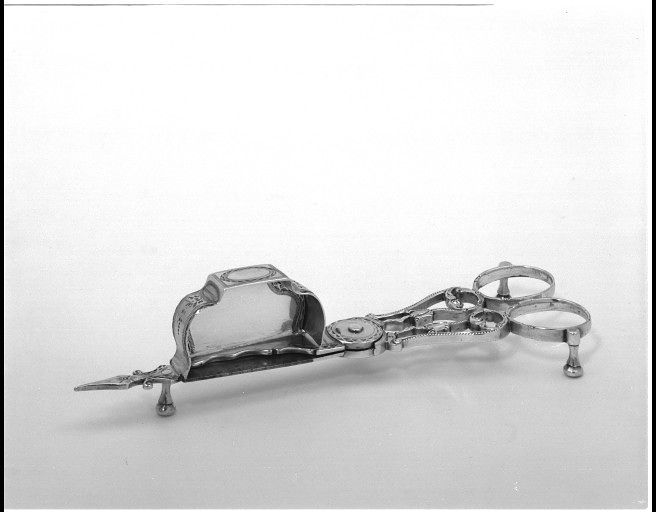
Snuffers
Place of origin:London (made)
Date:1785-1786 (made)
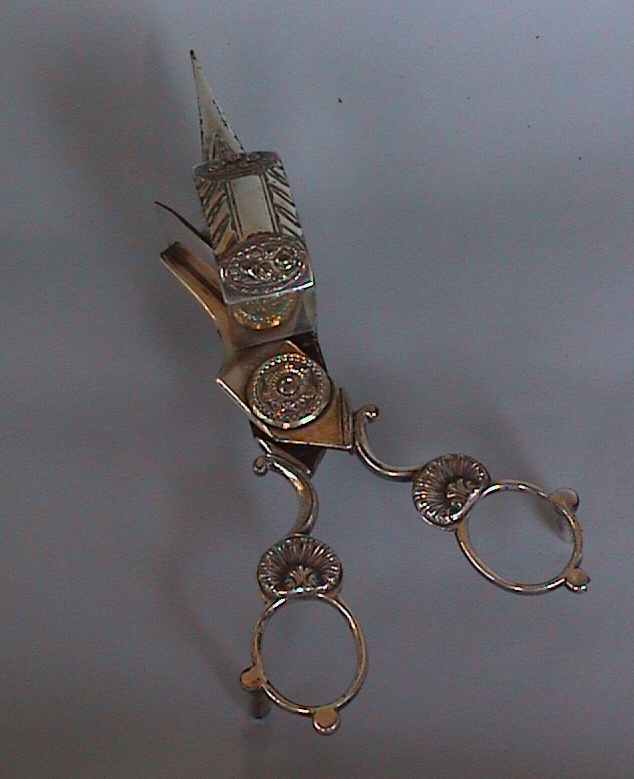
This 'close plating' scissor action candle snuffer stands on three feet and has fruits and floral ornaments with a pair of shells.
This snuffer is unmarked but very likely has English origin and was made between the end 18th / beginning 19th century.
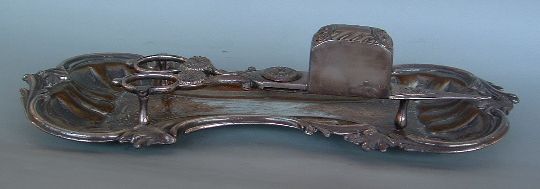
------------------


Snuffers and Stand with Extinguisher
Silver gilt
By John Bernard (act. 1685 - after 1720)
England (London)
-----------------------------------
Snuffers were first invented to cut off and retain the burned wicks of candles when the wax around them had melted; they were not necessarily used to extinguish the candle's flame. They are first recorded in the 15th century and numerous patents for snuffers are known from the middle of the 18th century, regularly reappearing with improvements until 1840 when candles that completely consumed their wicks were first developed, rendering snuffers superfluous.
---------------Колпачки для гашения--------------------
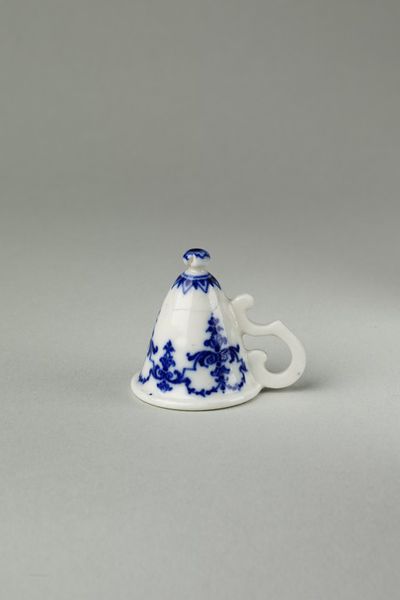
Candle snuffer
Place of origin:France (made)
Date:about 1720-1750 (made)



http://www.seashells.com/nautical.htm


http://collections.vam.ac.uk/item/O67511/taper-stand/




-------------- zuzlishka прислала ссылку на фотографии колпачков для тушения свечей из своей прекрасной коллекции, за что ей огромное спасибо!--------

Candle Snuffer

Candle Snuffer

Candle Snuffer
Butler's hand

Candle Snuffer
Butler's hand

Candle Snuffer
Bostonian settlers

Candle Snuffer Indian

Candle Snuffer Indian colonial style

Candle Snuffer

Candle Snuffer

Candle Snuffer

Candle Snuffer
Indian

Candle Snuffer
Indian

Candle Snuffer
German

Candle Snuffer
Randolf

Candle Snuffer
Randolf

Candle Snuffer
Italian tole

Candle Snuffer
Italian tole

Candle Snuffer

Candle Snuffer
"Two company"

Candle Snuffer

Candle Snuffer

Candle Snuffer

Candle Snuffer Nekrasoff(?) Art Nouveau

Candle Snuffer
Art Deco
http://www.flickr.com/photos/44210510@N06/
Еще драгоценная утварь-HERE-ТУТ
==================================
История свечей, очень интересная:
Майкл Фарадей
ИСТОРИЯ СВЕЧИ
http://vivovoco.rsl.ru/VV/Q_PROJECT/FAR/FARADAY1.HTM
Еще про свечи
http://ru.wikipedia.org/wiki/%D0%A1%D0%B2%D0%B5%D1%87%D0%B8
http://www.candles.ru/candle_history/
http://evolutsia.com/content/view/250/
свечи на картинах
http://commons.wikimedia.org/wiki/Category:Candles_in_art
http://collections.vam.ac.uk/
http://www.artfinding.com/
http://www.thebowesmuseum.org.uk/
http://images.google.ru/images?ndsp=20&hl=ru&newwindow=1&sa=3&q=antique+Bronze+CANDELABRA&btnG=%D0%9F%D0%BE%D0%B8%D1%81%D0%BA+%D0%BA%D0%B0%D1%80%D1%82%D0%B8%D0%BD%D0%BE%D0%BA
http://images.google.ru/images?hl=ru&newwindow=1&q=antique+Monumental+Bronze+CANDELABRA&sa=N&start=20&ndsp=20
http://antiques.rubylane.com/
http://newel.com/

"Долгоиграющая" свеча

Candlestick with a Figure of a Monkey-Conductor , Circa 1753

Из коллекции zuzlishka .Колпачок для тушения свечи
=============================================

A Candle maker
Object:Painting
Place of origin:Guangzhou (made)
Date:ca. 1790 (made)
Древние свечи значительно отличались от современных и содержанием и внешним видом. Используя доступные природные ресурсы, человек придавал свечам довольно причудливые формы. Некоторые свечи представляли собой длинные трубки из волокнистого материала, такого как камыш, наполненные смолой. В Китае и Японии свечи производили из воска. Его получали из насекомых и семян растений, а затем эту массу формовали в бумажные трубочки.
В получившуюся восковую форму помещали фитиль, который изготавливали из волокон растений. Много столетий спустя, в 18 веке, фитиль стал хлопковым, и его заливали жиром или воском, а не вставляли в готовую свечу.
Технология получения воска у каждого народа своя. Коренные американцы жгли масляную рыбу (candlefish), надетую на разветвленную палку. В юго-западных районах Северной Америки использовалась кора специального дерева, которую жгли, таким образом извлекая воск. Поселенцы Новой Англии жгли восковник - дерево, насыщенное смолой. Потом полученной массе придавали форму, вставляли фитиль.
Но подобные технологии были довольно трудоемкими и не оправдывали себя. К примеру, требовалось полтора кубометра восковника, чтобы сделать 8-дюймовую тонкую свечку. А потом, можете ли вы себе представить, как пахли и коптили эти свечи?
Потребность - мать изобретения. И человечество постепенно переходит к использованию животного жира для получения воска. Также начали использовать и пчелиный воск, в основном из-за его аромата. Эти свечи были довольно дорогим удовольствием, но горели намного ярче, чем их собратья из жира.
Несколько позже появился еще один материал, составивший большую конкуренцию воску и жиру - спермацет. Его получали из вещества, содержащегося в головах китов. Спермацетовые свечи горели намного ярче восковых - они были настолько яркими, что свет спермацетовой свечи использовался в качестве стандарта в фотометрии. Но по понятным причинам в 20 веке добыча спермацета была запрещена и прекращена.
В 15 веке сменилась технология формования свечи. Если раньше воск заворачивали, то теперь он заливался в готовую форму, которая после высыхания воска снималась.
-------------------Подсвечники-----------------------------

The Gloucester Candlestick
Object:Candlestick
Place of origin:England (made)
Date:1104-1113 (commmissioned)


Англия (сделано)
Date: Дата: 1104-1113 (commmissioned) 1104-1113 (commmissioned)

. This unique candlestick is a masterpiece of English metalwork, probably made by a goldsmith. It is made in three sections, each separately cast by a process known as 'lost wax'. The dense decoration is formed of wonderful figures and apes interspersed between thick intertwining shoots of foliage. Three long-eared dragons with outspread wings form the supporting feet. The large knop (or knob) in the centre of the stem shows the symbols of the four Evangelists.

-------------------------------
-----------------------свечное производство в Европе-----------------------
Свечи были очень дорогими, и не каждому хватало средств на их приобретение. Главным местом использования свечей были церкви, и таким образом церковь производила их для своих нужд, продавая часть этой продукции состоятельным семьям.
Такое положение вещей предстояло изменить. Не только лишь богатые жили на этом свете, и требовались заменители дорогих свечей для широкого общественного потребления. В этих целях около 13-го века для обеспечения менее зажиточных семей в Англии и Франции начали создаваться первые надомные фабрики свеч, где производились свечи для нужд жителей домов а также для последующей продажи.
Такие малые свечные производства и людей, которые там трудились, называли (Chandler-ami). Человеческая изобретательность не знает границ и вскоре возникали целые технологические линии, которые впрочем не выглядели как традиционные машины. Кто-то может подумать, что производство это было слишком примитивным, однако же на самом деле оно было весьма продуманным и практичным. Можно было производить все больше и больше не только на собственные нужды. Появлялись и первые машины. В таких надомных фабричках началось производство свечей, которые выделяли иной запах, нежели прежний «аромат» сгорающего жира. Наконец наметился определенный прогресс: начали добавлять ягоды барбариса, и это привело к тому, что во время сгорания выделялся сладкий, хотя и тошноватый запах, а пламя становилось ярче и чище.

Германия 1200-1400

Candlestick
Place of origin:Mosan (made)
Date:ca. 1200 (made)

Date:ca. 1300

Pair of candlesticks
Place of origin:Belgium (made)
Date:1450-1500 (made)

Подсвечники
Place of origin: Место происхождения: Germany (made) Германия (сделано)
Date: Дата: early 16th century (made) начале 16 века

Foot of an altar cross
Place of origin:Italy (made)
Date:1541 (made)
Artist/Maker:Unknown
Materials and Techniques:Gilt bronze, niello

Pair of candelabrum
Place of origin:Iceland (made)
Date:1590 (made)

Подсвечники
Place of origin: Место происхождения: Venice (city) (made) Венеция (город) (сделано)
Date: Дата: ca. ок. 1600 (made) 1600 (сделано)
С 14 до 17-го века, медные подсвечники появились во всех богатых домах. Socketed candlesticks made their appearance in the late 13th century and thereafter became relatively common, replacing the earlier pricket form, at least for domestic use. Socketed подсвечники появились в конце 13 века, заменив форму "годовалый олень".
Первый случай изменений с использованием иного рода сырья для производства свечей приходится на 18 век, когда в производстве начато использование спермацета (масло спермацетовое, олброт) - жидкая субстанция, содержащаяся в голове, а точнее - в огромном вместилище над правым носовым проходом кашалота. Спермацет свою текучую консистенцию сохранял только внутри кашалота. Однако и будучи извлеченным оттуда не был так тверд, как того хотелось бы. И хотя его открытие не решило проблему устранения неприятного запаха, однако же позволило придать свече большее пламя.

серебро 1740
Нимфа Дафна бежит от олимпийского бога Аполлона, мужской фигуры. She finally escapes by turning into a laurel tree, symbolising the victory of Chastity over Desire. Наконец, она убегает, превращаясь в лавровое дерево, символизирующее победу над желанием целомудрие. Figural candlesticks had been known in antiquity and were popular in Europe from the 16th century. Фигурная свеча была известна в древности и были популярны в Европе в 16 веке.

Chamber candlestick.
Place of origin:London (made)
Date:1744-1745 (hallmarked)
Artist/Maker:Crespin, Paul (maker)
Materials and Techniques:Silver, embossed, cast, chased and engraved, originally gilt

pair of candlesticks in giltbronze decorated with foliages and resting on a tripod base representing three winged lions.

19 век

pair of antique figural candlesticks modelled as emus standing on rocky bases. The candle tops having grape decoration. Height 25 cms. Circa 1890.
---------------------------------Переносные подсвечники-------------------------------

Candlestick
Place of origin:France (made)
Date:ca. 1700 (made)
chamberstick,подсвечник для спальни стороны- подсвечник предназначен для переноски, чтобы осветить путь в помещении. It consists of a small flat tray or shallow, saucer like dish with a low central support for the candle.

Figurine
Date:19th century (made)
Artist/Maker:Unknown
Materials and Techniques:Moulded bronze

Candlestick
Place of origin:Sheffield (made)
Date:early 19th century (made)


William IV Silver Chamber Stick
A small and extremely pretty antique sterling silver chamber stick with a naturalistic leaf base. Matching snuffer (unmarked). Base 7.5 cms x 7 cms. London 1833. By Taylor and Perry.

-----------------------------Коробочки-------------

Taper box
Place of origin:Sheffield (made)
Date:late 18th century (made)
в основном использовался для плавления сургуча и зажигать свечи, курительные трубки и т.д., а не как источник освещения.
A taper box or ‘bougie box’ was a cylindrical type of box to hold a wax taper coil. The name is derived from the French word for candle, bougie, which is derived in turn from Bougia, an Algerian town which exported wax. This box is an unusual variant in that the coiled wax was enclosed in an openwork, wire mesh cage. The taper was used mainly for melting sealing wax and for lighting candles, tobacco pipes etc., and not as a source of illumination.

Taper box
Place of origin:Sheffield (made)
Date:ca. 1790 (made)
A taper box or ‘bougie box’ was a cylindrical box to hold a wax taper coil. The name is derived from the French word for candle, bougie, which is derived in turn from Bougia, an Algerian town which exported wax.
The box, made of Sheffield plate, has a slip on cover with a tube or socket at the top from which the coiled taper can emerge and be held upright. Some taper boxes, like this example, had a candle extinguisher, a small hollow cone which was placed over the lighted taper to extinguish the flame without causing the snuff to smoke. The extinguisher is attached to the side by a short chain and a hook which slides into a sleeve. The taper was used mainly for melting sealing wax and for lighting candles, tobacco pipes etc., and not as a source of illumination
------------------------канделябры---------------

Candelabrum
Place of origin:London (made)
Date:ca. 1760 (made)
Artist/Maker:Stuart, James 'Athenian' (after, designer)
Anderson, Diederich Nicolaus (probably, maker)
Materials and Techniques:Ormolu (gilt bronze), with cast and applied decoration

Candelabrum
Place of origin:Birmingham (made)
Date:ca. 1771 (made)
Artist/Maker:Adam, Robert (probably, designer)
Boulton, Matthew (maker)
Materials and Techniques:Blue-john (fluorspar) with gilt bronze and silvered copper mounts

Candelabrum, Centrepiece
Place of origin:London (assayed)
Date:1813-1814 (hallmarked)
Artist/Maker:Storr, Paul (maker)
Materials and Techniques:Silver-gilt, raised, cast, chased, engrav

Pair of Louis XVI Style Gilt Bronze Seven Light Candelabra after the model by François Rémond for Le comte de Artois' Turkish boudoir at Versailles.
François Rémond (1747 -1812), was a leading Parisian gilder and bronze caster during the second half of the 1700s.

Pair of large candelabra with five branches, in gilded and patinated bronze. It is in the shape of a woman dressed in the Greek fashion, standing on a square pedestal and bearing the lights on her head and in her hands.
18th century

A Large and Very Finely Cast Pair of Ormlu, Bronze and Marble Figural Candelabra, After A Model by Clodion. Claude Michael Clodion, (1738-1814),

An Impressive Pair Of Palatial Louis XV Style Figural Ormolu Mounted Imari Porcelain Candelabra On Ebonised Stands.
В 19 веке происходит расцвет свечного дела. Появляются первые сообщения о свечах стандартных из спермацета, рецептурах и способах их изготовления. Очевидно, что каждая мануфактура имела свои технологические секреты, однако вскоре употребляется слово стандарт, что указывает на то, что свечи начали производиться массово с применением указанного сырья и по определенной технологии. Наконец решена проблема коптящих фитилей. Внедряются фитили прессованные и плетеные, что позволило улучшить качество горения и стабильность пламени свечи.
Французский химик Мишели Эжен Шеврел в 1820 году изобрел фантастическое сырье, которое по сей день применяется в качестве улучшителя парафина. Речь идет о стеариновой кислоте, получаемой из кислоты жирных животных путем гидролиза в условиях высокой температуры под большим давлением. Слишком сложно и невозможно было получение такого сырья в домашних условиях тех времен, однако было положено начало исследованиям в области новой технологии. Стеариновый воск был крепким, твердым и горел чисто. Так одним махом были решены проблемы прочности материала, качества и чистоты горения, а в сочетании с изобретением плетеных фитилей свечи приблизились к идеалу. Правда, дальнейшее использование натурального сырья, получаемого из животных, их количество (имеются в виду кашалоты) стремительно уменьшалось.
-----------------ампир------------------------

Very rare and important pair of torches bronze eight arms of light, then Prime Empire
----------------------------

Empire Bronze Doré Candelabra

Chiselled
Main material : Gilded bronze
Period of creation : 1810
Country of creation : France

Empire Bronze Doré Candelabra
----

Gilded bronze
Period of creation : 1810
Country of creation : France

1830
В 1834 году Йозеф Морган сделал прорыв в будущее, сконструировав машину для производства свеч. Это было механическое устройство, в котором впервые применялась форма. Она имела вид цилиндра, снабженного двигающимися поршнями, которые выталкивали готовую, уже остывшую свечу. Изобретение такого оборудования существенно увеличило массовое производство свеч.
Последнее упоминание о важнейшем изобретении в свечном деле относится к 1850 году, когда на рынке впервые появилось сырье, получаемое не из животных. Это был парафиновый воск, в дальнейшем названный парафином, производимый путем отделения натуральных восковых субстанций из нефти. Это был продукт в наибольшей мере соответствующий требованиям, предъявляемым потребителями свечей. Он имел кристаллически белую окраску, был прочным, горел небесно-белым пламенем и не выделял неприятного запаха.
======================Канделябры-цветы=======

Pair of crystal chandeliers and gilded bronze, creating signed "E. enote, PARIS. 19th century

Pair of crystal chandeliers and gilded bronze, creating signed "E. enote, PARIS.
-------------------------
---------------

One of a Pair of Candelabra, c.1855
Collection: Ceramics
One of a pair of candelabra, c.1855 Hard-paste porcelain, coloured enamels and gilt-bronze Painted with a portrait of Marie-Antoinette French, Monbro Height:

candelabrum
One of a Pair of Candelabra, c.1855
One of a Pair of Cabndelabra, c.1855
Portrait of King Louis XVI
Hard-paste porcelain, coloured enamels and gilt-bronze
French, Monbro
Period: Napoleon III

Large 19th Century Pr. French Brass Floral Candelabra

A unique pair of French brass floral candelabra from the 19th Century, having 9 lights and intricately embellished with brass leaves and grapes. Please view all pictures to appreciate the great detail and quality.

pair of French brass floral candelabra from the 19th Century

Impressive 19th Century French Bronze Candelabra
-----------------------------Настенные подсвечники----------------------------------------

Italian Renaissance style (19th Cent) metal wall sconce bracket of arm in armour holding torch

Italian Renaissnce style (19th Cent) carved and painted wall sconce of arm holding torch with kneeling figure

LION MASK SCONCES-КАНДЕЛЯБРЫ
Pair Carved Wood Gilt Lions Mask with Arms Venetian 18th C.

Pair of Italian Renaissance style (19/20th Cent) gilt metal wall sconces with winged griffin form with new 8 sided shade

Exceptional pair of carved wood sconces, gilding and silvering of origin. Rome, XVIII.
45,000 €

Girandole
Place of origin:London (probably, carved)
Date:1760-1765 (made)
Artist/Maker:Johnson, Thomas (after, designer)
'Girandole' is an Italian name for a wall light. Wooden wall lights were introduced in the late 17th century and were common by the mid-18th century. The Rococo style gave free reign to the carver's invention.

A pair of French Louis XV style gilt bronze sconces with three light branches shaped as foliage and a rocaille stem ornamented with flowers.

Each sconce is made in the form of lyre, culminating in the top two heads Zefirov and adorned with laurel branches, with a mask of Apollo in the center 19 век

Pair of French Neoclassical Mid-19th Century Gilt and Patinated Bronze Five Light Wall Lights. Circa: 1850.

A Large and Important Pair of French 19th Century Louis XV Style Gildwood Carved Six Light Wall Appliques, Circa: Paris, 1870
40,000 €

Pair of gilt bronze appliques on fire two lights, with cherub's face, Louis XV, 1745 circa.

Pair of large three-light sconces. By Jean-Joseph de Saint-Germain. Probably executed after a drawing by Jean-Louis Prieur. Paris around 1765 - the end of Louis XV period. Ormolu.
----------------------Напольные большие канделябры---------

19th century

A pair of gilt wrought iron torch holders

Pair of Italian Baroque style stripped pine, beech & poplar 24 arm floor torcheres with 3 scrolling legs on horses (in the manner of Piranesi, 19th Century & with replacements)


Candlestand
Place of origin:London (probably, made)
Date:1756-1760 (made)
Artist/Maker:Johnson, Thomas (probably, designer and maker)
Materials and Techniques:Carved and painted pine, with iron branches and gilt-brass nozzles
This is one of a set of four stands made to hold candelabra to light a room. The lively design with imagery from nature is typical of the Rococo style in Britain in the 1760s.
============================Фарфоровые канделябры==


Париж (возможно, и сделал)
Fontainebleau (possibly, made) Фонтенбло (возможно, и сделал)
Date: Дата: ca. ок. 1547-1559 (made) 1547-1559 (сделано)
Artist/Maker: Исполнитель / Производитель: Palissy, Bernard (possibly, maker) Палисси, Бернард
"faïence Анри де-II", поскольку эмблема французского короля и его жены Екатерины Медичи, вместе с тем, как тогда думали, его любовницы Дианы де Пуатье

Неизвестный мастер

Candlestick with a Figure of a Monkey-Conductor , Circa 1753
Pair of Bronze Candelabras with Porcelain Flowers & Birds

Meissen porcelain manufactory.

Four Seasons Porcelain Candelabra by Samson & Sons-

FRENCH BRONZE & PORCELAIN BIRD BRANCH ORNAMENTAL DISPLAYS

PAIR FRENCH ORMOLU BIRD BRANCH DISPLAYS PORCELAIN FLOWERS
pair of highly decorative bronze branches with porcelain birds and flowers.

PAIR GERMAN PORCELAIN PARROT CANDELABRAS CANDLE HOLDER

Porcelain at Baltimore Museum of Art
-----------------------По мотивам басней Эзопа-----------------------

Candlestick
Part of a pair of Fable candlesticks. This candlestick illustrates Aesop's fable of the Fox and the Tiger.
c. 1765

Candlestick
Part of a pair of Fable candlesticks. This candlestick illustrates Aesop's fable of the Leopard and the Fox.
С хрустальными подвесками
Фарфоровых и хрустальных подсвечников много очень интересных, их покажу в отдельном посте.
==========================Долгоиграющие свечи=================
Спасибо всем, кто написал комментарии к картинке-загадке, а особенно тем, кто прислал фото сербских свечей, я и многие френды не знали, что такие до сих пор есть. Вот еще старинные:

Taper stand
Place of origin:Sheffield (made)
Date:ca. 1820 (made)
Artist/Maker:Unknown
A taper stand, or wax jack, is a device to hold a turpentined wax taper upright while burning. With this example, the coiled taper is wrapped around the vertical post with one end held in the horizontal snuffers, which are two semi-circular blades. The wax taper was used mainly for melting sealing wax and for lighting candles, tobacco pipes etc., and not as a source of illumination.
Sheffield plate originated, with the discovery in 1742, that bars of silver and copper, in unequal proportions, fused by heating under pressure, could be rolled into sheets of laminated metal and worked like silver. The industry this material created flourished for about 100 years until superseded by electroplating in the 1840s.

Taper stand
Place of origin:England (made)
Date:1650-1700 (made)
Artist/Maker:Unknown
Materials and Techniques:Pierced and engraved brass
Его размер и сложные украшения свидетельствуют, что он занимал центральное место в домашнем хозяйстве, наверное, в одном из основных общественных помещений, чтобы зажечь свечи на весь дом. Silver versions of the design of this taper stand are also known.Ownership & Use Собственность & использованию
The coil of taper is held in a split plate tensioned by a spring. Катушка конуса проходит в расколе пластина натянут пружиной. This serves to keep the end of the taper vertical and allows it to burn down only as far as the plate should the flame be left burning. The wax-covered taper would be softened by the heat of the flame and the split plate would then close extinguishing the flame. This was an important feature at a period when accidental fires were very frequent because of the use of lamps and candles for light. Это было важным элементом в период, когда очень часто случались пожары из-за использования ламп и свечей для света.
Materials & Making Материалы & внесении
The pierced designs and engraved dials indicate that this taper stand was either made by a craftsman who was a specialist maker of cases for lantern clocks or was made for a clockmaker, of familiar elements to complement his trade. были либо сделаны мастером, который был специалистом чайник случаев для фонаря часов или было сделано для часовщика, знакомые элементы, которые дополняют его торговли.

An antique sterling silver wax jack with circular base and carrying handle, wax winder and a candle snuffer with chain attached. Height 14 cms. Sheffield 1807. Silver candle snuffer matched.
http://www.waxantiques.com/candlesticks.htm
-------------Ножницы для срезания нагара-----------------------
Тушители Snuffers были впервые изобретены для того, чтобы отрезать фитили свечей, когда вокруг них воск растаял, они не обязательно использовались для тушения пламени свечи. Они впервые появились в 15 веке и многочисленные патенты на такие ножи известны с середины 18 века, регулярно появлялись до 1840 года, когда были разработаны свечи, в которых полностью сгорают фитили, поэтому ножи стали ножи излишними.

Snuffers
Place of origin:England (made)
Date:1547-1553 (made)
Ножницы Эдуарда VI вместе с Богом надписи 'Сохранить KYNGE' и 'EDWARDE Wythe все его благородные COUNCEL. Edward, the only surviving son of Henry VIII was king from 1547 to 1553 and was succeeded by his half-sisters Mary and Elizabeth. Эдвард, единственный сын Генриха VIII был королем с 1547 по 1553 и ему наследовал его сестры Марии и Елизаветы. The snuffers were passed down through the family of his uncle, Edward Seymour, Duke of Somerset and Lord Protector, who was the brother of Jane Seymour, the King's mother. Ножи были передаются из поколения в семье своего дяди, Эдвард Сеймур, герцог Сомерсет, и лордом-протектором, который был брат Джейн Сеймур, мать царя.

Snuffers
Place of origin:London (made)
Date:ca. 1700 (made)
Artist/Maker:John Chartier (maker)
Materials and Techniques:Silver
----------------------------------

Snuffers with stand
Place of origin:England (made)
Date:ca. 1720 (made)
Сальные и восковые свечи горели быстрее, чем фитиль. Lit candles required constant attention. Зажженные свечи требовали постоянного внимания. Snuffers were used to trim the wicks (to prevent them curling over) and the burnt wicks were captured in the box compartment. Тушители были использованы для отрезания фитилей (чтобы предотвратить их скручивание и сожженных фитили были захвачены в поле отсеке. Snuffers supported in an upright holder such as this were fashionable about 1720. Тушитель поддерживается в вертикальном держателе- как это было модно около 1720.

Snuffer tray and snuffers
Place of origin:Sheffield (made)
Date:ca. 1820 (made)
------------------------

Snuffers
Place of origin:Birmingham (made)
Date:1830-1840 (made)
Artist/Maker:J. Hobday (maker)
Materials and Techniques:Close-plated iron or steel, with lead-filled silver

-----------------------

Snuffers
Place of origin:Sheffield (made)
Date:early 19th century (made)


Snuffers
Place of origin:London (made)
Date:1785-1786 (made)

This 'close plating' scissor action candle snuffer stands on three feet and has fruits and floral ornaments with a pair of shells.
This snuffer is unmarked but very likely has English origin and was made between the end 18th / beginning 19th century.

------------------


Snuffers and Stand with Extinguisher
Silver gilt
By John Bernard (act. 1685 - after 1720)
England (London)
-----------------------------------
Snuffers were first invented to cut off and retain the burned wicks of candles when the wax around them had melted; they were not necessarily used to extinguish the candle's flame. They are first recorded in the 15th century and numerous patents for snuffers are known from the middle of the 18th century, regularly reappearing with improvements until 1840 when candles that completely consumed their wicks were first developed, rendering snuffers superfluous.
---------------Колпачки для гашения--------------------

Candle snuffer
Place of origin:France (made)
Date:about 1720-1750 (made)



http://www.seashells.com/nautical.htm


http://collections.vam.ac.uk/item/O67511/taper-stand/




-------------- zuzlishka прислала ссылку на фотографии колпачков для тушения свечей из своей прекрасной коллекции, за что ей огромное спасибо!--------

Candle Snuffer

Candle Snuffer

Candle Snuffer
Butler's hand

Candle Snuffer
Butler's hand

Candle Snuffer
Bostonian settlers

Candle Snuffer Indian

Candle Snuffer Indian colonial style

Candle Snuffer

Candle Snuffer

Candle Snuffer

Candle Snuffer
Indian

Candle Snuffer
Indian

Candle Snuffer
German

Candle Snuffer
Randolf

Candle Snuffer
Randolf

Candle Snuffer
Italian tole

Candle Snuffer
Italian tole

Candle Snuffer

Candle Snuffer
"Two company"

Candle Snuffer

Candle Snuffer

Candle Snuffer

Candle Snuffer Nekrasoff(?) Art Nouveau

Candle Snuffer
Art Deco
http://www.flickr.com/photos/44210510@N06/
Еще драгоценная утварь-HERE-ТУТ
==================================
История свечей, очень интересная:
Майкл Фарадей
ИСТОРИЯ СВЕЧИ
http://vivovoco.rsl.ru/VV/Q_PROJECT/FAR/FARADAY1.HTM
Еще про свечи
http://ru.wikipedia.org/wiki/%D0%A1%D0%B2%D0%B5%D1%87%D0%B8
http://www.candles.ru/candle_history/
http://evolutsia.com/content/view/250/
свечи на картинах
http://commons.wikimedia.org/wiki/Category:Candles_in_art
http://collections.vam.ac.uk/
http://www.artfinding.com/
http://www.thebowesmuseum.org.uk/
http://images.google.ru/images?ndsp=20&hl=ru&newwindow=1&sa=3&q=antique+Bronze+CANDELABRA&btnG=%D0%9F%D0%BE%D0%B8%D1%81%D0%BA+%D0%BA%D0%B0%D1%80%D1%82%D0%B8%D0%BD%D0%BE%D0%BA
http://images.google.ru/images?hl=ru&newwindow=1&q=antique+Monumental+Bronze+CANDELABRA&sa=N&start=20&ndsp=20
http://antiques.rubylane.com/
http://newel.com/